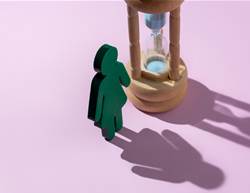Sculptor Jo Caminiti describes her time in perimenopause as “a bit like the frog in the pot that's slowly being brought to the boil—you don't actually know what's going on,” she says.
For her, it started with disruptions to her sleep.
“It was my early- to mid-40s. I was starting to have sleep disturbances. But I'd had a marriage breakdown. I was a single mum, I was working full time. So, of course, you're gonna have sleep disturbances.
“And there was also other things going on: the waking up the 3am with a racing heart and racing mind; the creeping despondency about work, the lack of joy in life.”
At the time, she didn’t know that these were symptoms of perimenopause.
“I didn't know what was going on. I'd never heard perimenopause, I did not link it to my hormones. I had regular periods, right through my early 50s. So that wasn't a sign and I still didn't have hot flushes.”
What is perimenopause?
Remember when you got your first period? It was a day that marked the beginning of menstruation, a new phase in your life. So it’s understandable that we may think menopause is going to be the same.
In fact, menopause is much less clear-cut. Technically, ‘menopause’ is the single day that is 365 days after your last period. Every day beyond that you are ‘post-menopausal’ while every day before that you were in ‘perimenopause’.
And perimenopause, on average the four to six years before menopause, is a time of gradual transition, and it can be quite a bumpy ride for some women, while for others, the symptoms are barely noticeable.
The lesser-known perimenopause symptoms
For those who do suffer, the symptoms are not always the typical ‘hot flushes’ and here lies the challenge: there is no scientific test for perimenopause, so the diagnosis can be elusive.
Jo’s perimenopause journey might sound extreme, but it serves as an important reminder that perimenopause can be many things, and the symptoms aren’t always hot flushes and patchy periods.
According to Jean Hailes for Women’s Health, other symptoms can include:
- Sleep disturbances
- Breast tenderness
- Itchy or dry skin
- Exhaustion
- Trouble concentrating
- Mood changes
- Vaginal dryness
- A change in sex drive
- Migraines
- Weight gain
Finding the right perimenopause treatment
It wasn’t until Jo was caught a TV program on menopause that the penny dropped about her own symptoms. So, she joined an online support group, read up some more, and then went to her doctor and requested menopause hormone therapy (MHT). Her doctor argued, wanting to put Jo on antidepressants, which Jo fiercely resisted.
“I had to put her on the spot and say, ‘Do you have something against menopausal hormone therapy?’ Reluctantly her doctor then asked ‘All right, what do you want?’
“I had to tell her what I wanted from the looking into the recommendations on the Australasian Menopause Society website”.
Once Jo took the medication, the relief was immediate. “I had the first decent night's sleep in about eight years. I could actually walk instead of hobbling with joint pain. And to then get energy back and enthusiasm back and trust in my own body, and that it's gonna not let me down is amazing.”
Other treatment options include the contraceptive pill, lifestyle changes and some complementary therapies like black cohosh, says Jean Hailes for Women’s Health.
If any of the above symptoms sound familiar, perhaps you too are wondering whether you’re heading into perimenopause.
“It should be one of the first questions that gets asked of someone in their 40s, who are feeling the wheels are starting to fall off life.
“Ask the question, ‘Could perimenopause be contributing to this?’ That's the most important thing. And be aware that it can contribute in so many different ways, both physically and psychologically.
For more information, read up on what to ask your doctor about menopause. Plus, the Australasian Menopause Society offers a range of fact sheets about menopause.
Listen to Jo discuss her perimenopause journey on our podcast here.










.png&h=193&w=250&c=1&s=1)
.jpg&h=193&w=250&c=1&s=1)
